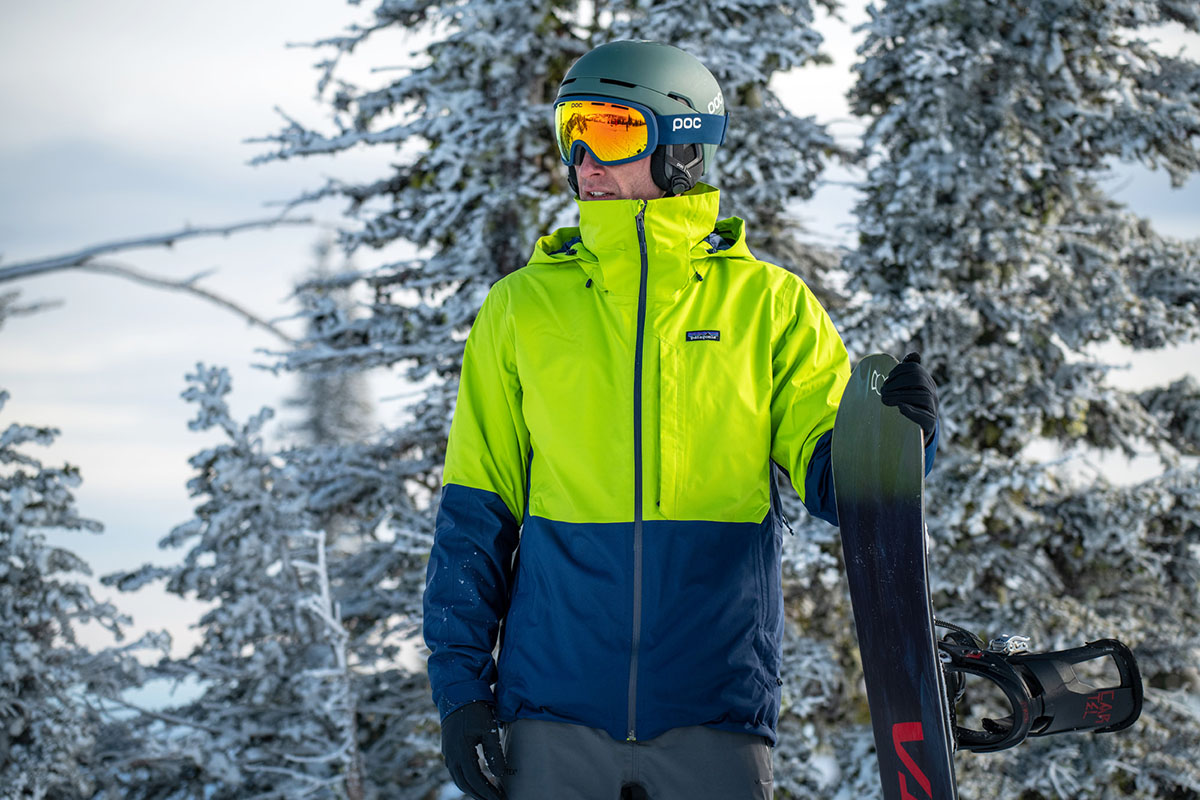
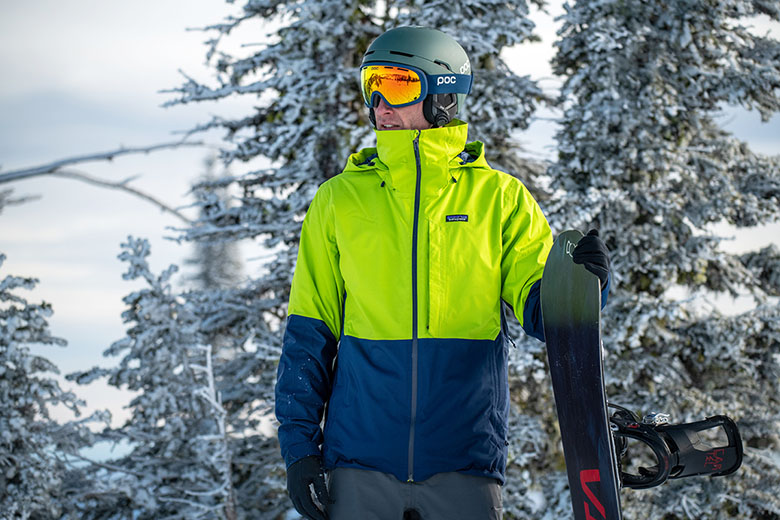
Price: $399
Waterproofing: 2L H2No
Insulation: 60g Thermogreen
What we like: 3-in-1 versatility and sustainably built.
What we don’t: A number of performance letdowns and boxy fit.
See the Men's Patagonia 3-in-1 Snowshot See the Women's 3-in-1 Snowbelle
Patagonia’s Snowshot (and women’s Snowbelle) is the company’s leading resort offering and comes in a number of variations, from a standard hardshell to a 3-in-1 jacket. In testing the latter model this past winter, we were impressed with its sturdy protection and warmth but came away with a number of complaints: it’s heavy and bulky, the zip-out jacket is cheaply made, and the fit was boxier than we prefer. Those set on an integrated design will find value and versatility in the build, but it’s currently our least favorite Patagonia ski/snowboard jacket (the Insulated Snowshot/Snowbelle are far better). Below we break down the 3-in-1 Snowshot’s weather protection, warmth, comfort, breathability, durability, fit and sizing, and more. To see how it stacks up, see our article on the best ski jackets.
For weatherproofing, the Patagonia 3-in-1 Snowshot Jacket uses the company’s well-respected 2-layer H2No construction. Combined with a durable water repellent (DWR) finish and moderately thick face fabric, the jacket has done a good job shedding all forms of moisture, from wet and heavy snow to blowing sleet and light powder. And when combined with the synthetic midlayer, it effectively blocked strong gusts of wind. The build is certainly heavy and bulky, but it’s a standout in rough weather. That said, without the insulated jacket, we did find the Snowshot to be drafty in particularly blustery conditions with gusts up to 50 miles per hour—wind cut right through the torso area and chilled us even though temperatures were mild (in the mid 20s Fahrenheit).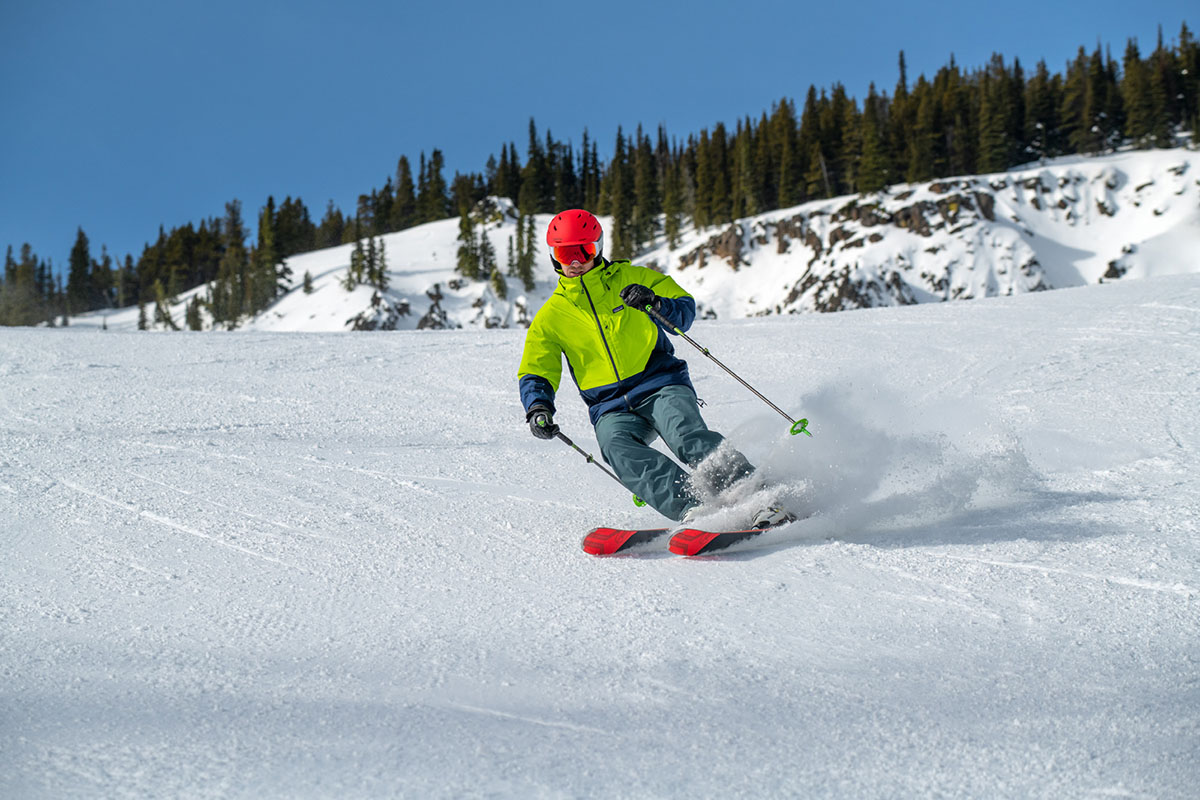
As far as protective features go, the Snowshot comes well-equipped to seal out the elements. The hood design is among the best we’ve seen in a 3-in-1 piece, with a large shape that fits nicely around a helmet, a bill for keeping snow away from your goggles, and good all-around adjustability (although it’s hard to tweak the fit without removing your mittens or ski gloves). In addition, the collar of the jacket sits very high—it reaches my top lip—and proved to be a nice place to duck into to hide from the wind. That said, I did find that the powder skirt is blocked by the insulated jacket when it’s zipped in (a confusing design choice). Ditching the midlayer or wearing the insulated jacket without zipping it into the shell makes it functional, but that defeats the purpose of opting for a 3-in-1 build.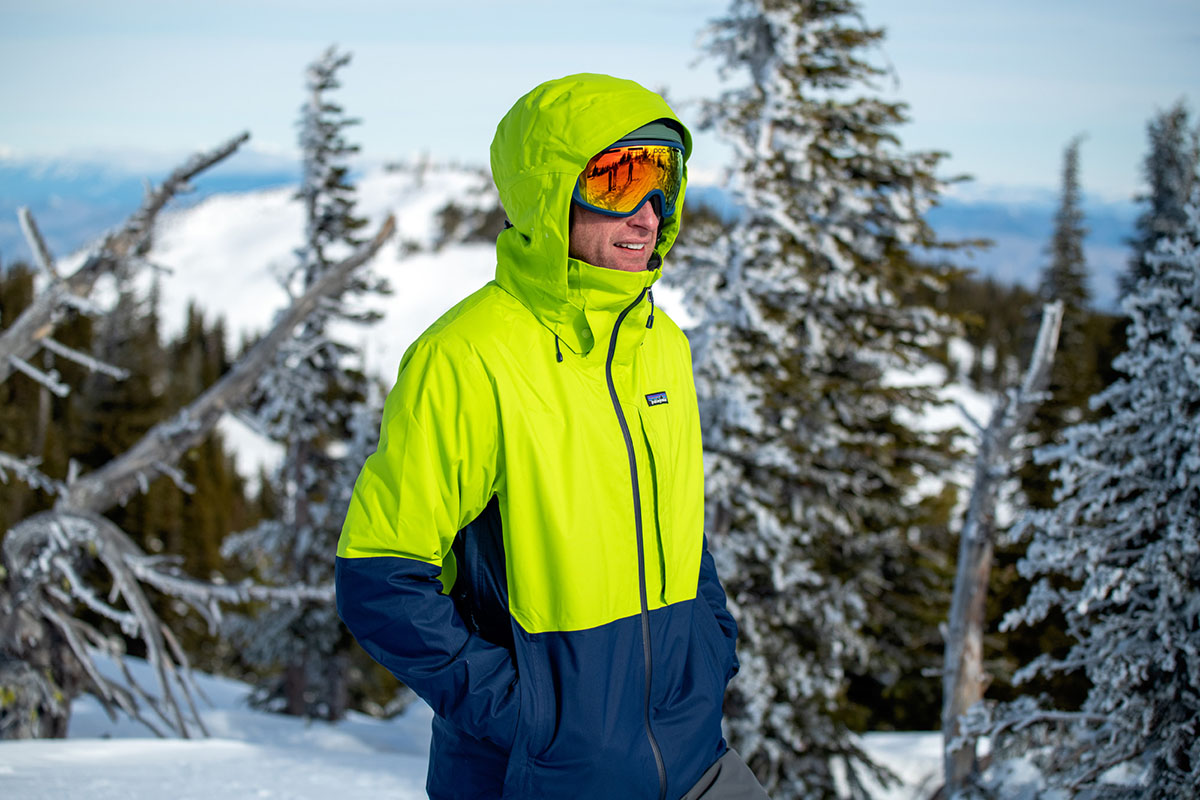
In the case of the 3-in-1 version of the Snowshot, insulating responsibilities fall on the zip-out synthetic jacket. With 60-gram synthetic Thermogreen fill used throughout, it offers moderate levels of warmth. Combined with a quality baselayer and the outer shell, the Snowshot kept us comfortable lapping the resort on days with temperatures in the low to high 20s Fahrenheit. Depending on activity level and if you run cold or hot, we expect most skiers to find it warm enough down into the high teens. Anything lower for riding groomers, and we’d need to add layers. And of course, one of the biggest advantages of a 3-in-1 is that you can ditch the midlayer if you’ll be very active (more on this in “Breathability” below) or on sunny and balmy spring days.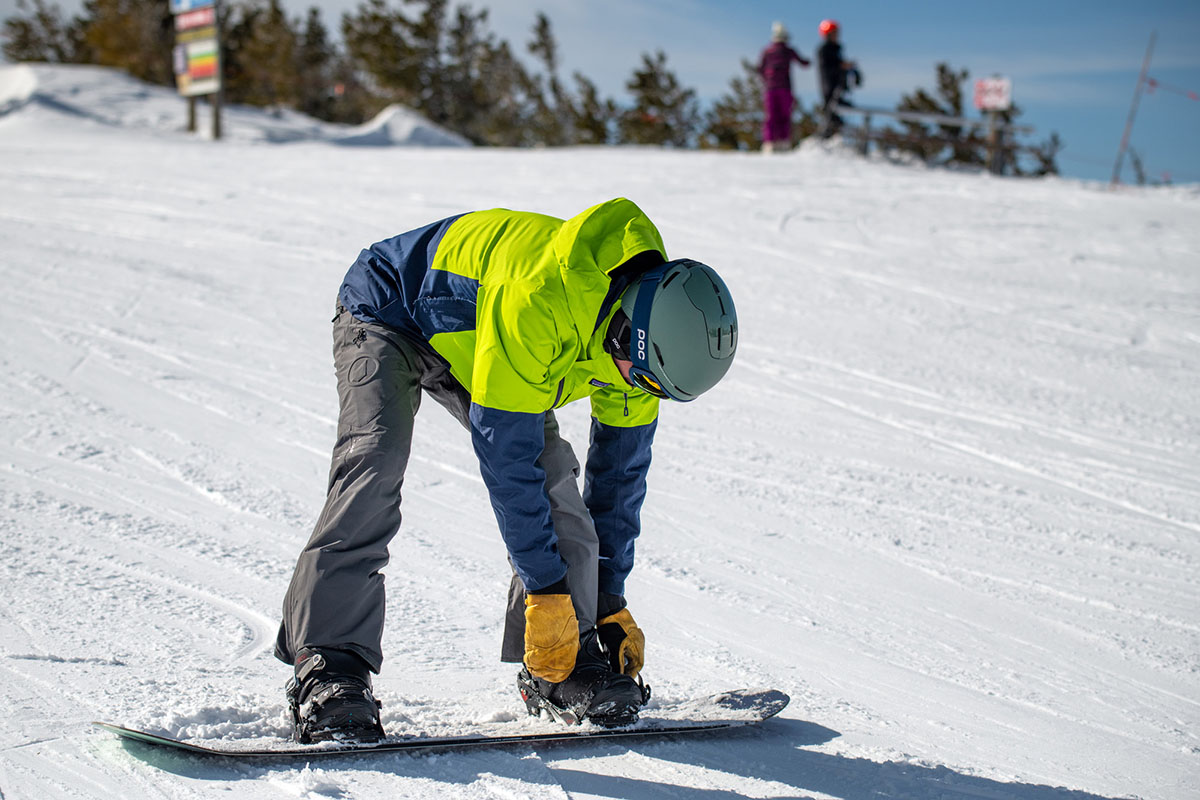
Like most 3-in-1 jackets, the Snowshot isn’t a standout when it comes to comfort. The insulated midlayer feels fairly heavy and bulky, and the slick liner isn’t particularly soft (and it does a poor job wicking moisture away too). Wearing just the shell over a baselayer lightens it up, but the hanging mesh liner and boxy fit doesn’t make for a cozy combo. It’s worth noting that we tested the standard insulated Snowbelle (the women’s variation of the Snowshot) and found it to be a far more comfortable and supple place to be. All that said, I did really appreciate the massive patches of fleece-like material on the inside of the collar—a feature I sorely missed on the upgraded Patagonia Powder Bowl—which allow it to fit nicely over the insulated jacket to provide protection when you’re wearing just the shell or with the zip-out midlayer.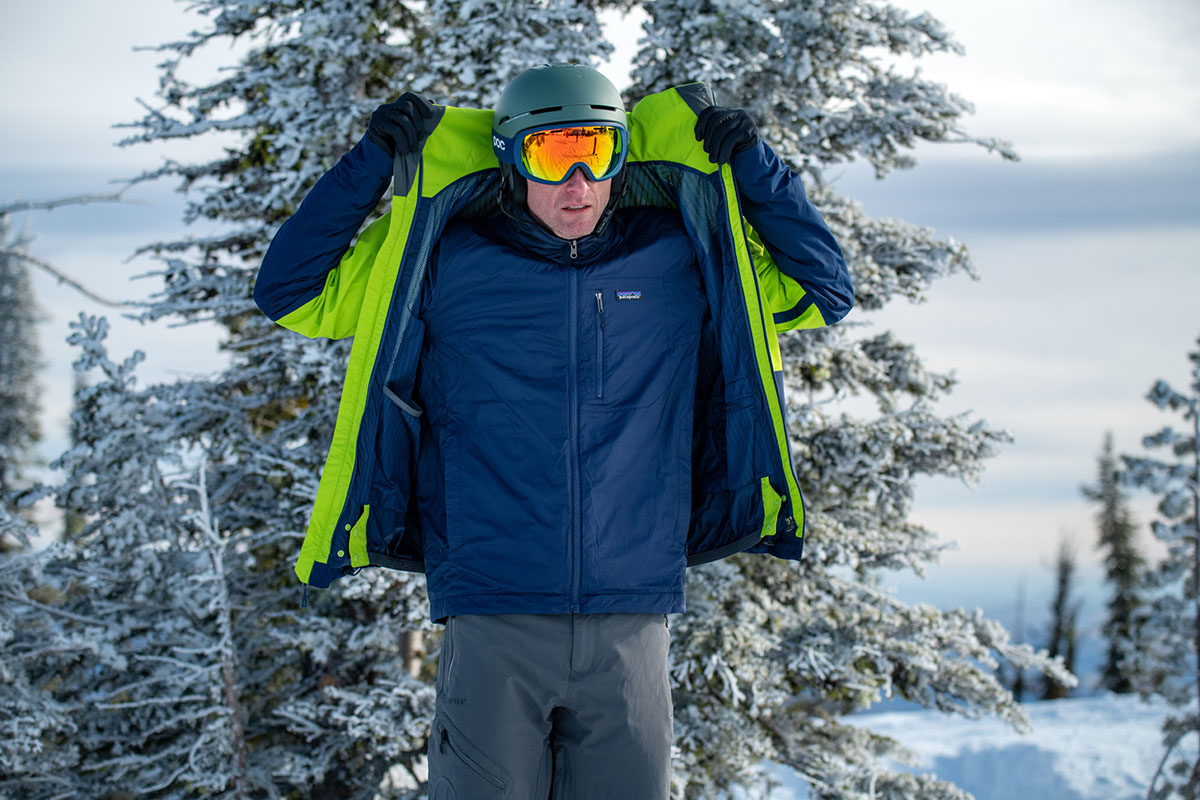
As expected, breathability wasn’t a strong suit for the Patagonia 3-in-1 Snowshot, and we don’t recommend it for active skiers or those that like to explore the sidecountry. For starters, wearing it with the midlayer is a recipe for a swampy interior, as all of the layers from the zip-out jacket as well as the outer shell trap a lot of warmth. And opening up the pit zips doesn’t offer much relief because the midlayer is still enclosed and thus can’t dump heat (one advantage of choosing an insulated ski jacket, as unzipping the pit zips opens up both the shell and insulating portions). And even when we wore just the shell over a baselayer and opened the pit zips, we were disappointed with the jacket’s breathability. As our snowboard tester put it on a very windy day: “the jacket appeared to have good ventilation, but unfortunately that ventilation was in the inward direction.” In the end, the combination of sweat building up along the interior and a lot of wind coming through the open zippers resulted in an uncomfortable 15-minute hike.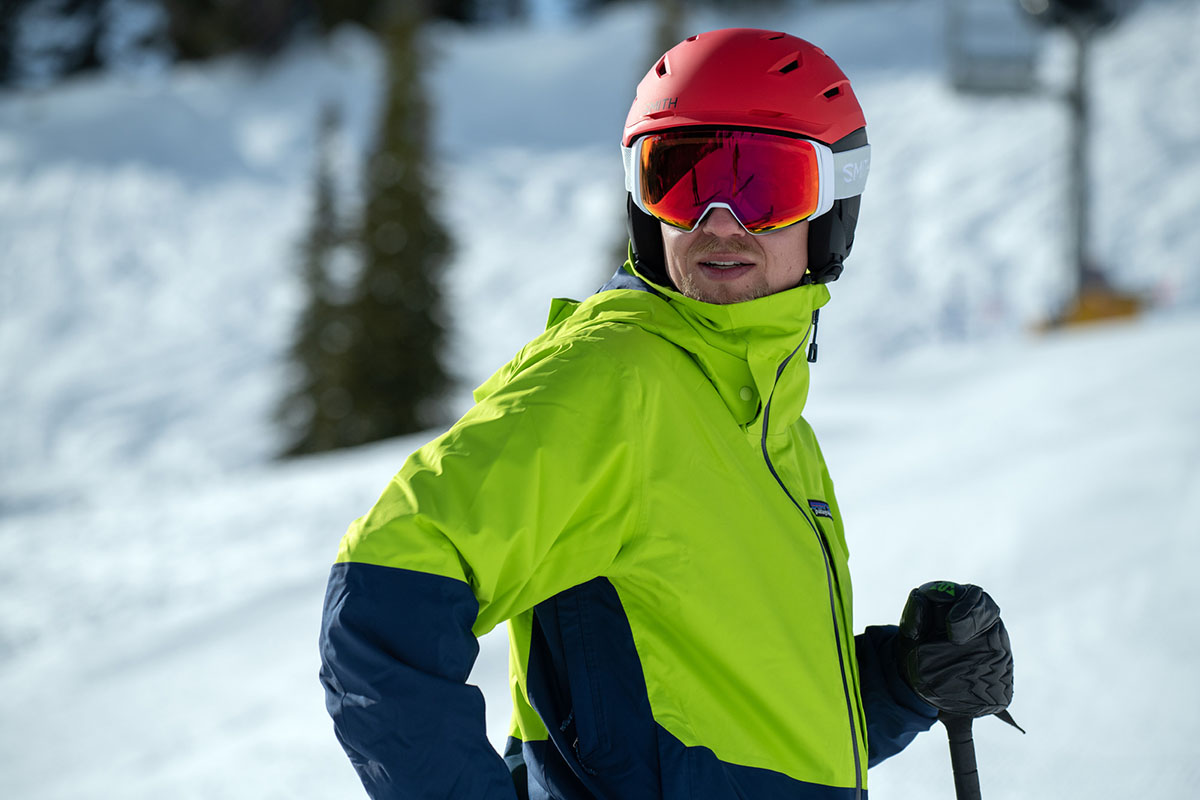
Weight is yet another compromise inherent with the Snowshot’s 3-in-1 style. All of the extra zippers, buttons, and fabric layers tack on a fair amount of weight, and at nearly 3 pounds (2 lbs. 15.1 oz., to be exact), the Snowshot is rather hefty. Most standard insulated jackets are around 2 pounds or a little more, including Helly Hansen’s Alpha 3.0 (2 lbs. 3 oz.) and the insulated variation of the Snowshot (2 lbs. 0.5 oz.). Even among 3-in-1 competitors, the jacket falls on the high end: The North Face’s ThermoBall Eco Snow Triclimate undercuts it slightly at 2 pounds 13.9 ounces, while Columbia’s cheaper Wild Card Interchange is similar at 2 pounds 15 ounces. And it’s not just heavy on paper: unfortunately, the jacket’s extra bulk is noticeable and has an impact on both comfort and mobility.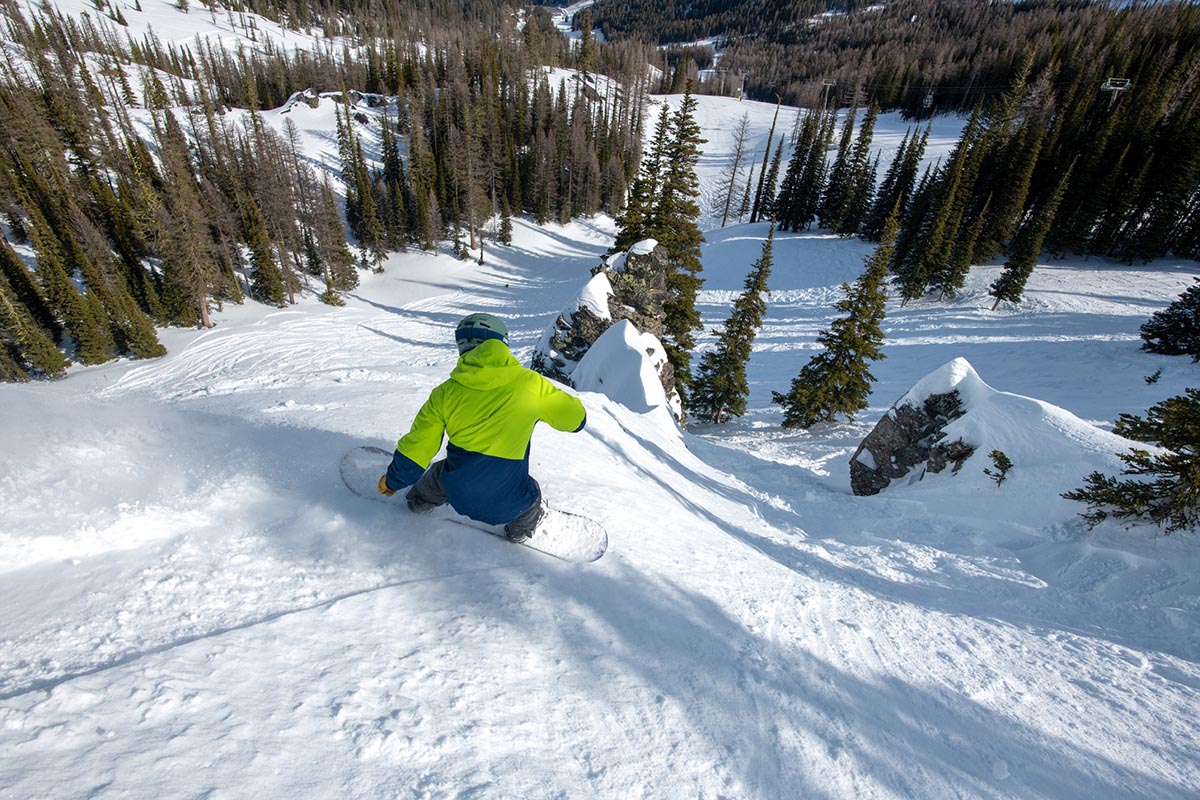
Build quality is a bit of a mixed bag with the 3-in-1 Snowshot. Here’s the good news: the outer shell has a nice hand feel, and overall weather protection has been decent. In addition, the 75-denier face fabric is substantial and has held up admirably thus far in testing. In fact, we’ve had no durability issues at all to date. However, we do have a number of design-related complaints, from the awkward powder skirt mentioned above to the non-adjustable hem on the zip-off jacket (more on this below). Some of the problems are inherent with the 3-in-1 build—it’s never going to feel as light and performance-oriented as a standalone insulated jacket—but the Snowshot never felt particularly special, which is something you can usually count on from Patagonia. Considering its fairly steep $399 MSRP (among the costliest 3-in-1s available), it doesn’t strike us as worth the investment at full price.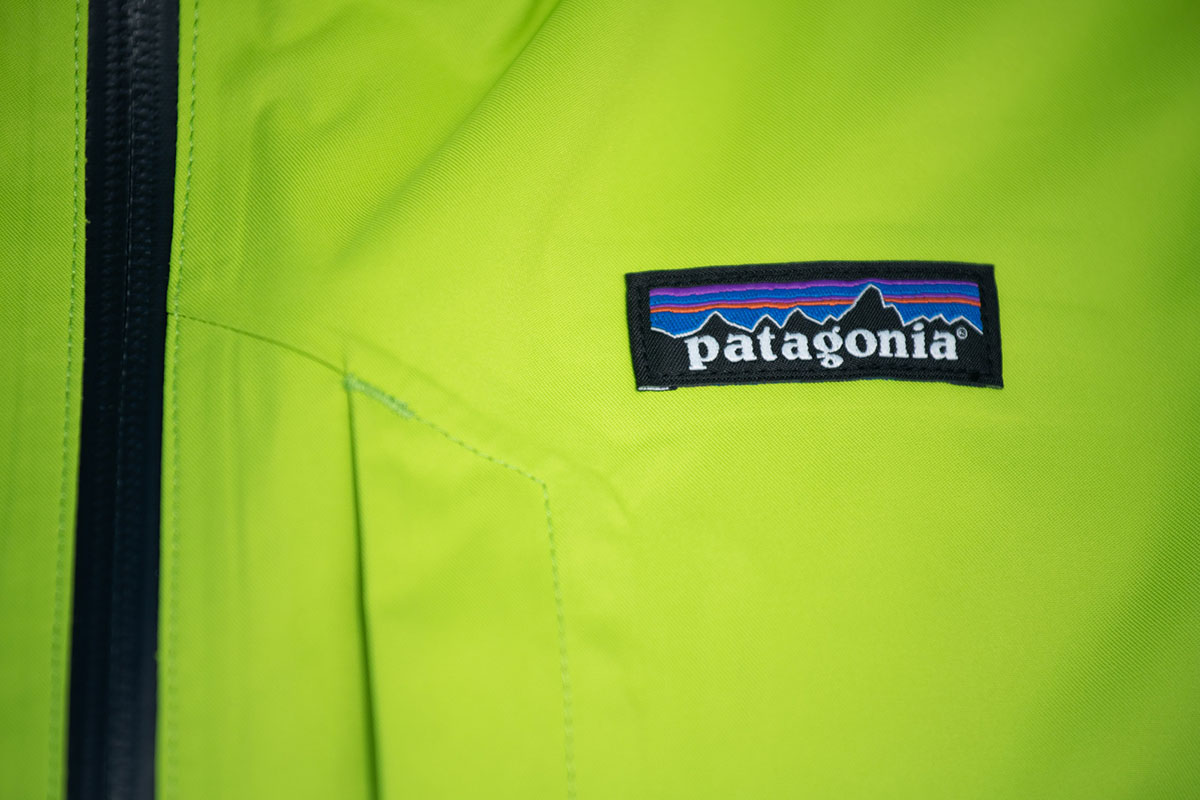
One of the main reasons to get a 3-in-1 jacket is the included zip-out midlayer, which gives you versatility to leave it behind on warm days, wear it as a standalone around-town piece, etc. If you’re familiar with these types of jackets, separating the layers will be quite intuitive: the insulated jacket zips into both sides of the outer shell and is connected to each sleeve with a button, and another button secures it at the back of the neck.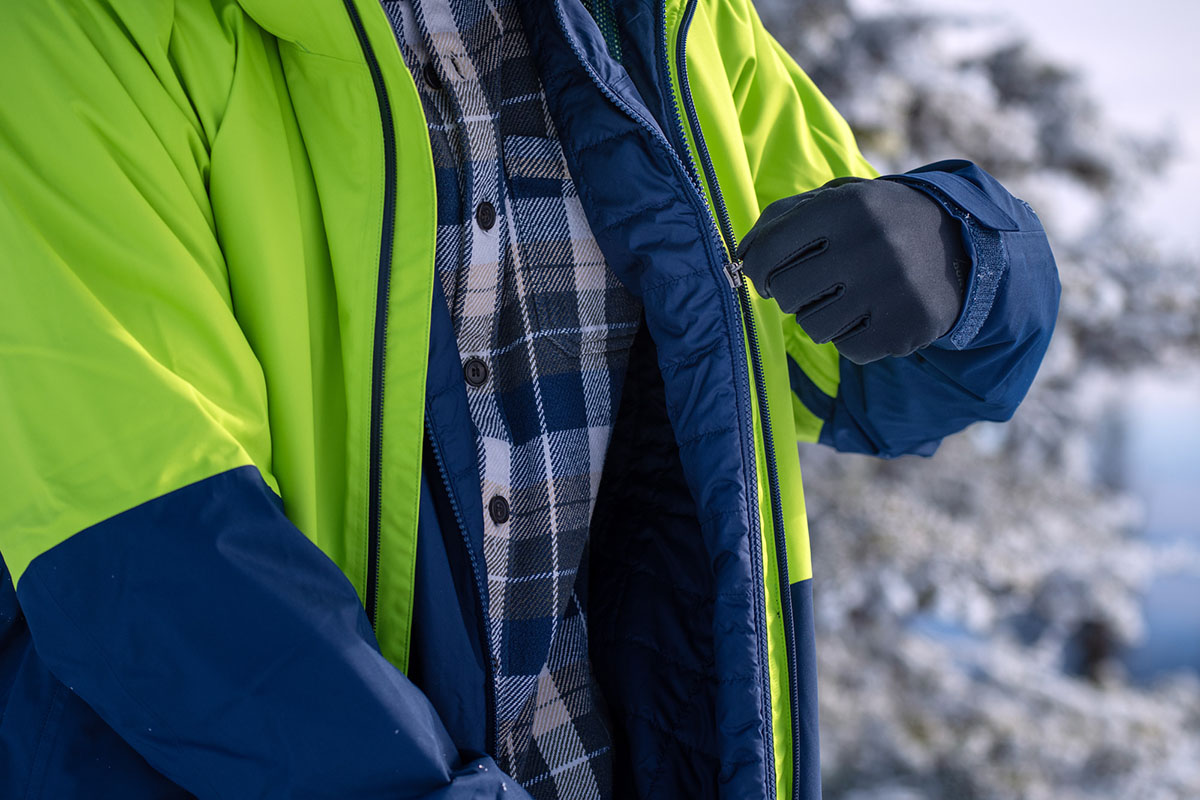
As we mentioned above, the zip-out insulated layer has 60-gram synthetic fill, which offers sufficient warmth when worn on its own on most shoulder-season days. In addition, the jacket is reversible, so you can swap between styles (one side has quilting while the other has a smooth lining) and pockets (the smooth side has two hand pockets and a chest pocket along the exterior). That said, there are a number of pitfalls, the most significant of which is the combination of a boxy and large fit and non-adjustable hem. As such, our jacket fit extremely loose around the waist with no way to cinch it up. In the end, it’s not the kind of piece you’d want to wear around town, which again is one of the main reasons to choose a 3-in-1 in the first place.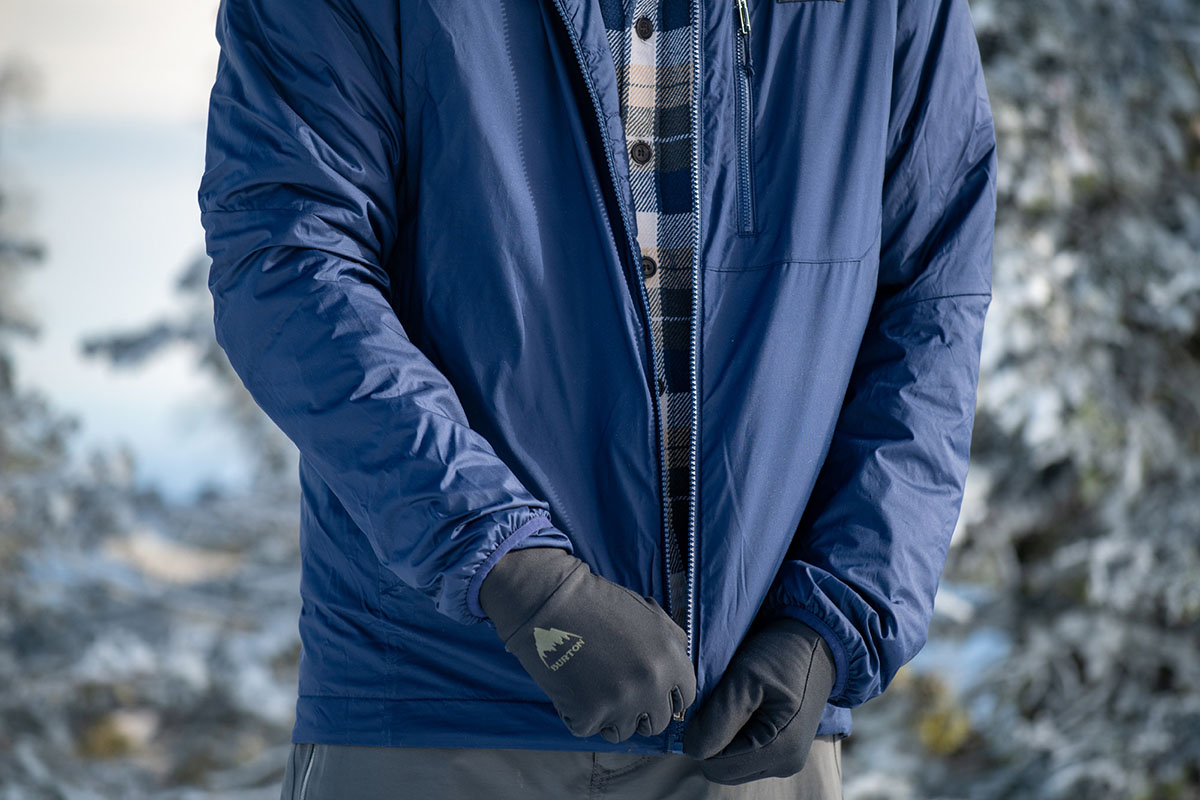
Overall, the Patagonia 3-in-1 Snowshot’s hood is highly effective at sealing out the elements. We’d prefer a little more protection along the sides, but it’s plenty good in most conditions and stays securely in place even during a fall and high winds. One nice touch is that it’s among only a few hoods that allow you to fit it over a helmet without lowering the main zipper. That said, the cinches are nearly impossible to loosen with mittens, and it’s only slightly better for gloves and bare hands. Tightening them is easier—just give a solid pull to the cords at the back and sides. And a final note regarding the hood: it can be removed on mild days with a series of buttons and a zipper at the back (without the hood, face and neck protection is still sufficient thanks to the tall collar).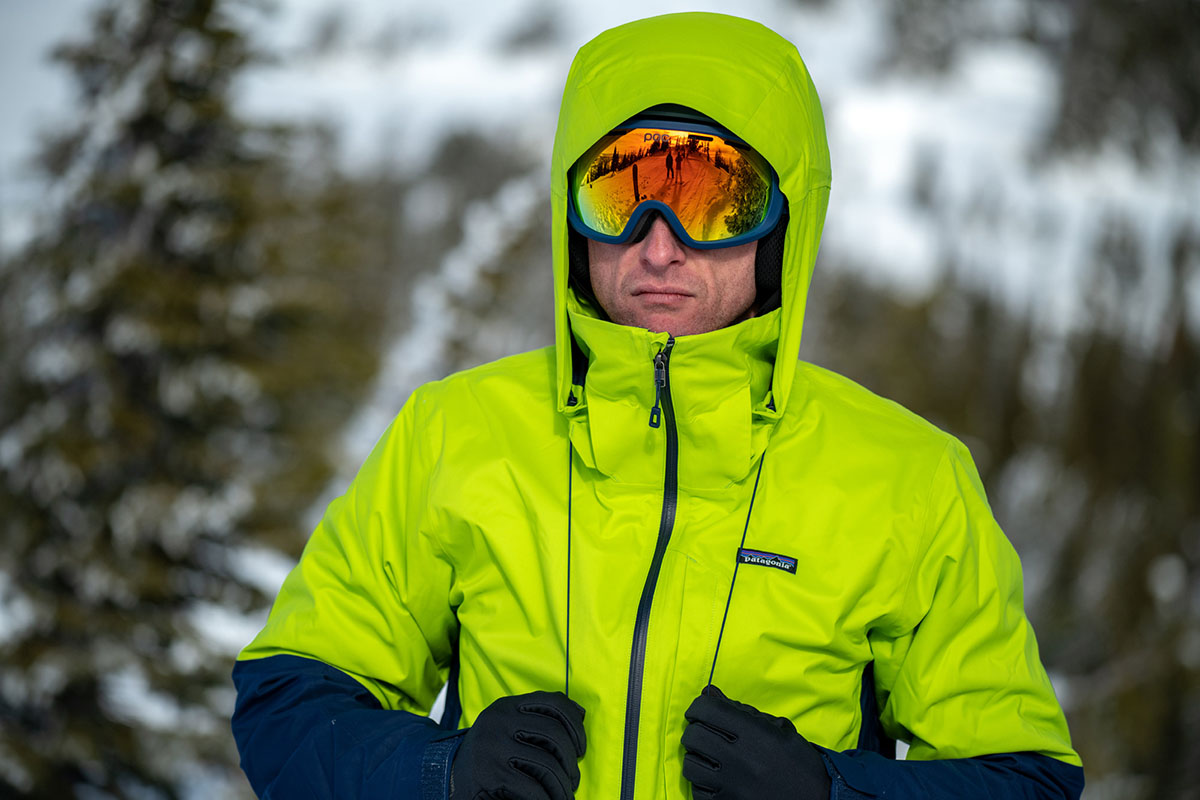
Put simply, the Snowshot’s lack of usable organization was a little frustrating. The exterior chest pocket is moderately sized, but it’s fairly shallow and doesn’t provide the security we prefer in the main storage compartment. There is also an interior zippered pocket on the shell as well as a mesh dump pocket, but both are completely entombed with the midlayer zipped in place, making them unreachable. The exterior hand pockets are zippered and functional, but this isn’t our preferred place for stashing keys, a phone, or other such items as they get in the way when bending down to strap in or sitting on a chairlift. 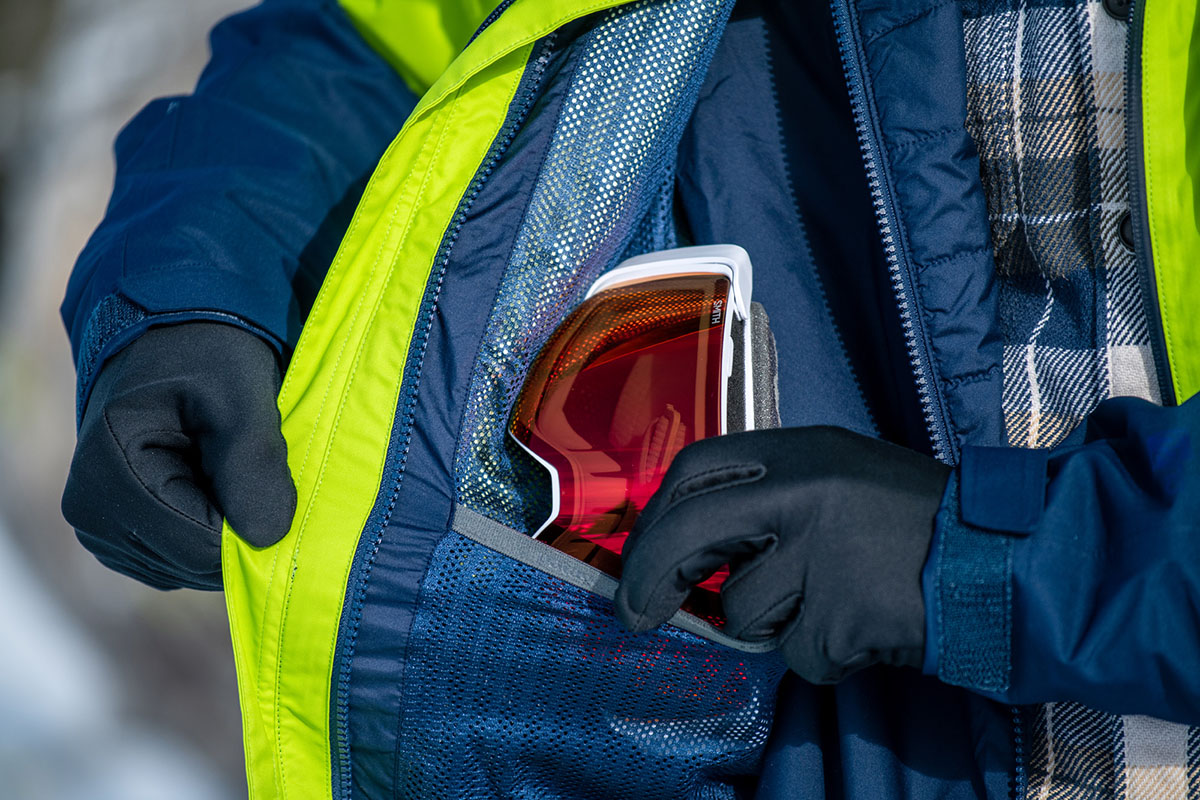
Patagonia products typically strike us as very thoughtfully designed, but we think they came up short with the Snowshot’s included powder skirt. With the midlayer connected, the powder skirt is hidden behind the hem of the insulated jacket, and connecting it leads to some awkward bunching. In the end, if we wanted to use the powder skirt, we wore the two layers separately. The powder skirt does include the fabric loop and button that allow you to connect the jacket to a pair of compatible Patagonia snow pants (currently all of their pants are compatible), but the button is right in the middle of the lower back, which is a common location to hold a snowboard while hiking. It was enough of an annoyance that our snowboard tester couldn’t bootpack with his board in his preferred spot. For skiing, however, the placement wasn’t an issue.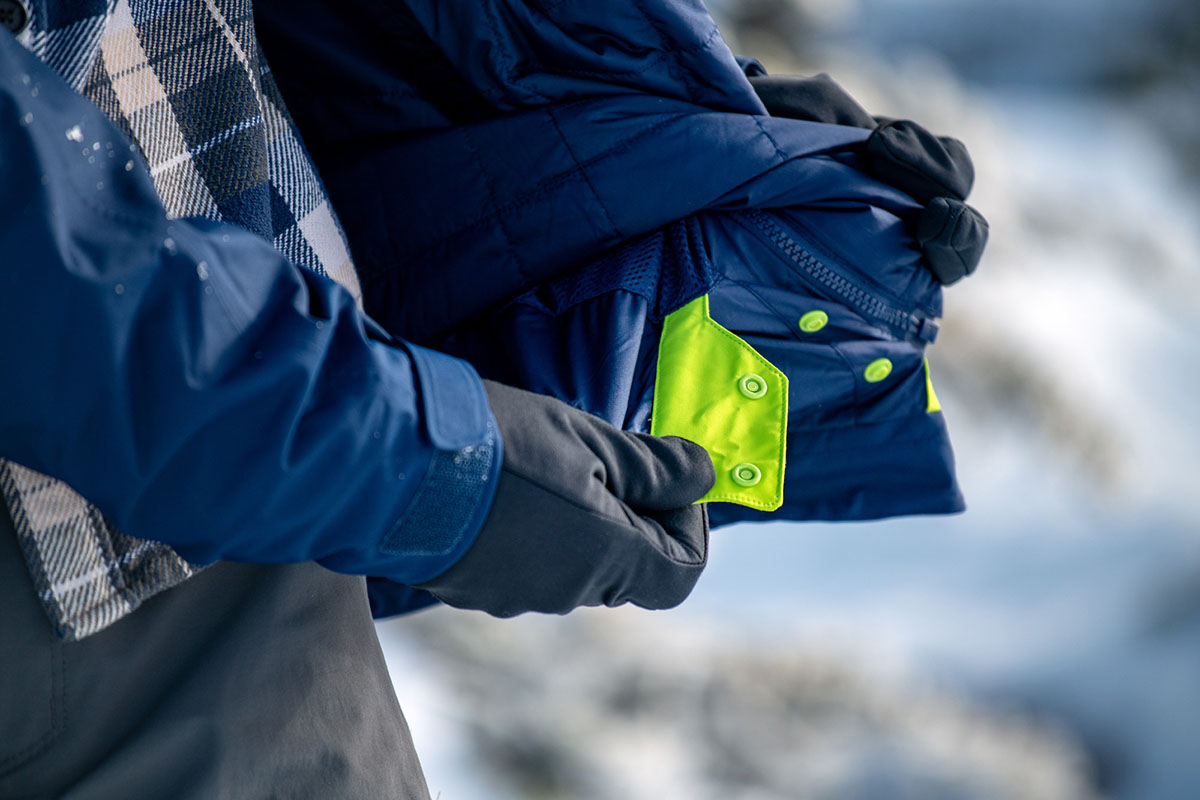
As we’ve found with most of Patagonia’s ski collection, the 3-in-1 Snowshot has a boxy fit and was rather large for both of our testers (5’9” and 155 lbs. and 6’ and 165 lbs.), even with the zip-out jacket attached. That said, we wouldn’t recommend sizing down, as the fit around the shoulders was good and would likely be tight for us in a size small (we both wore a medium). We did like the center back length, however, which measures 30 inches. For reference, it stacks up competitively to some of our favorite resort offerings this year, including Patagonia’s own Powder Bowl (31 in.) and Arc’teryx’s Sabre AR (31 in.) and top-of-the-line Macai (29.75 in.). In use, it was an ideal length for resort riding, with enough coverage for sitting on a chairlift and riding in powder.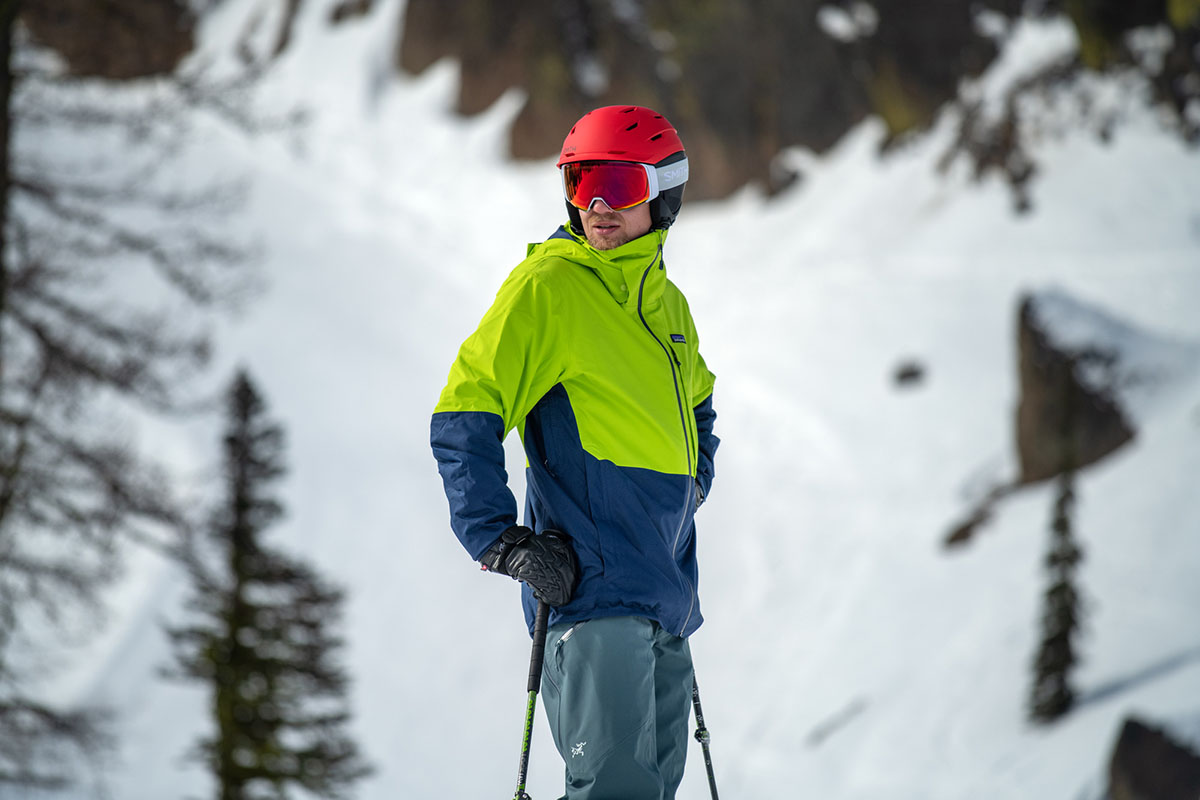
One of the biggest draws to the Patagonia 3-in-1 Snowshot is its focus on sustainability. For starters, the jacket’s 2-layer shell is 70-percent-recycled polyester, and the 60-gram synthetic insulation is 90 percent recycled. The lining fabric (minus the body and sleeves) is also bluesign-approved, meaning that the chemicals and materials used in its production are safe for the environment, workers, and consumers. Finally, the Snowshot is Fair Trade Certified Sewn, which indicates that Patagonia put extra money into the manufacturing process to fairly compensate workers and ensure they have a safe working environment. Patagonia is an industry leader in sustainable practices, and we really appreciate the measures they took with the Snowshot.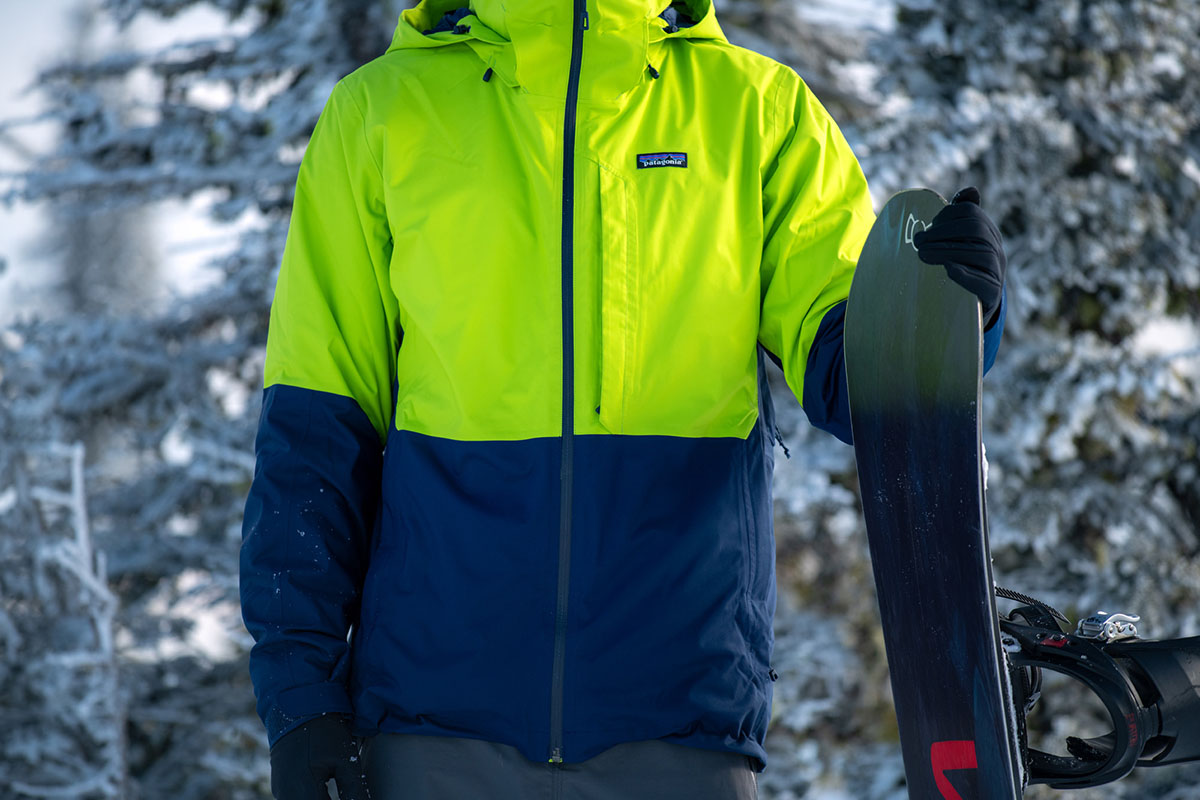
We hit the slopes with the 3-in-1 Snowshot for this review, but as we touched on above, the collection includes a number of other variations. For more active skiers, the standard, non-insulated Snowshot is a nice alternative: it’s over a pound lighter at 1 pound 13.3 ounces, costs $100 less at $299, features the same 2-layer H2No waterproofing, has functional storage, and the pit zips are much more adept at dumping heat. We also like the Insulated Snowshot, which costs $329, weighs 2 pounds 0.5 ounces, and forgoes the separate midlayer for an integrated design with 80-gram synthetic in the body and 40g in the sleeves (more on this model below). Finally, if you prefer to pair your kit, Patagonia offers the Snowshot Pants, which connect to any of the jackets’ powder skirts.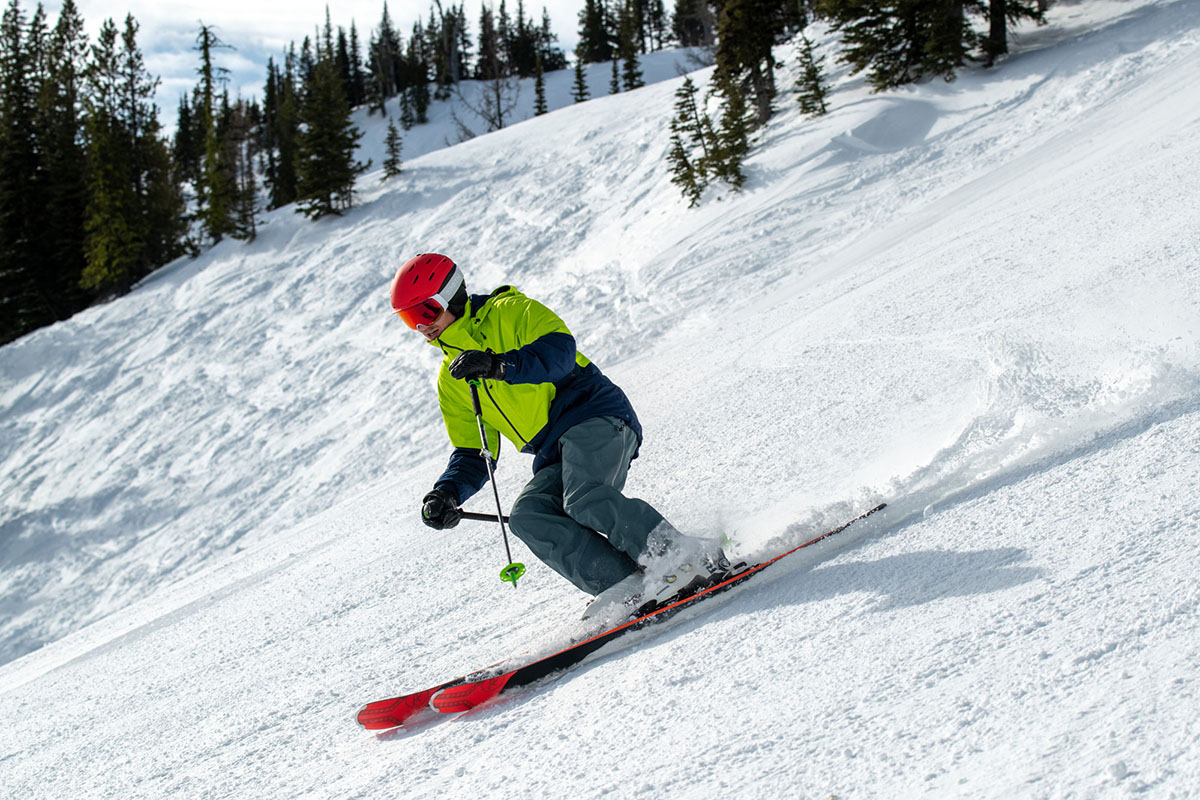
In addition to the men’s Snowshot collection, Patagonia also makes the jackets in women’s-specific versions called the Snowbelle. Stacked up against the men’s 3-in-1 model tested here, the women’s 3-in-1 Snowbelle costs the same at $399 but weighs slightly less at 2 pounds 8.7 ounces and comes in different colorways. Otherwise, the two sport identical feature sets and overall constructions. And like the men’s Snowshot, the Snowbelle is also offered in an insulated design and pant variations, although there is no uninsulated shell option.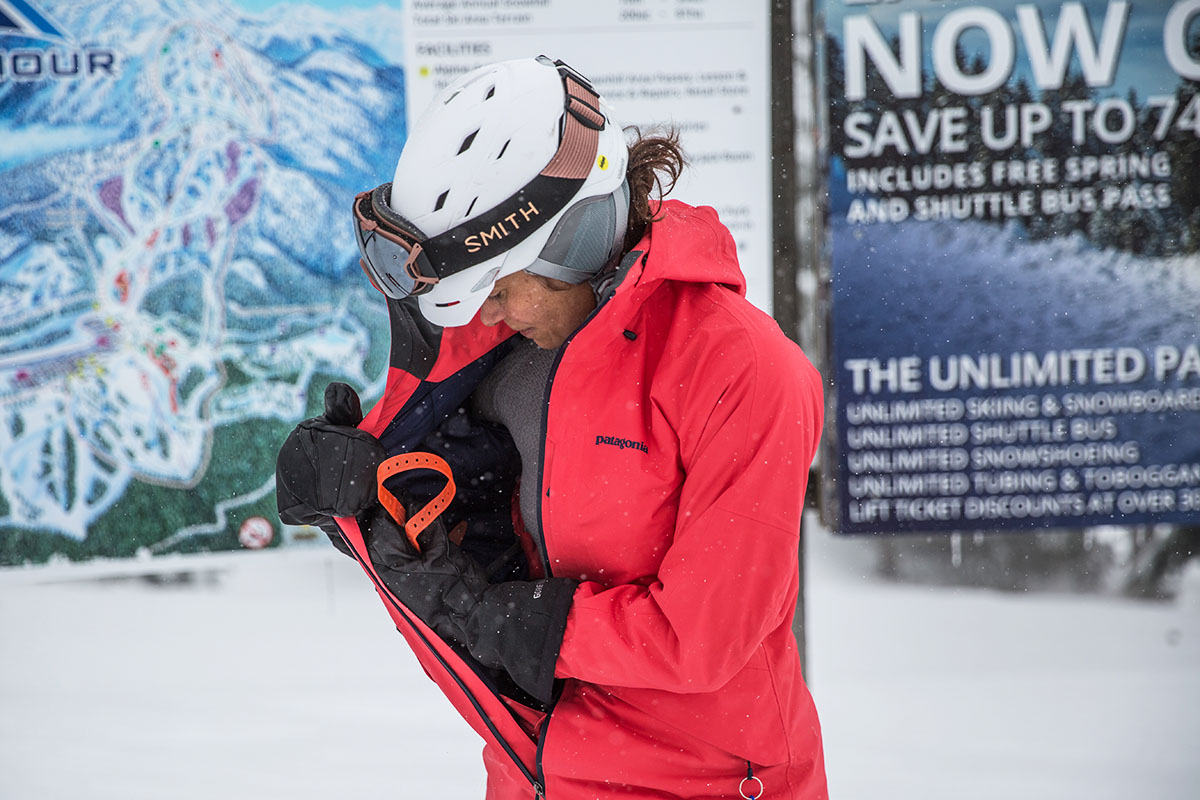
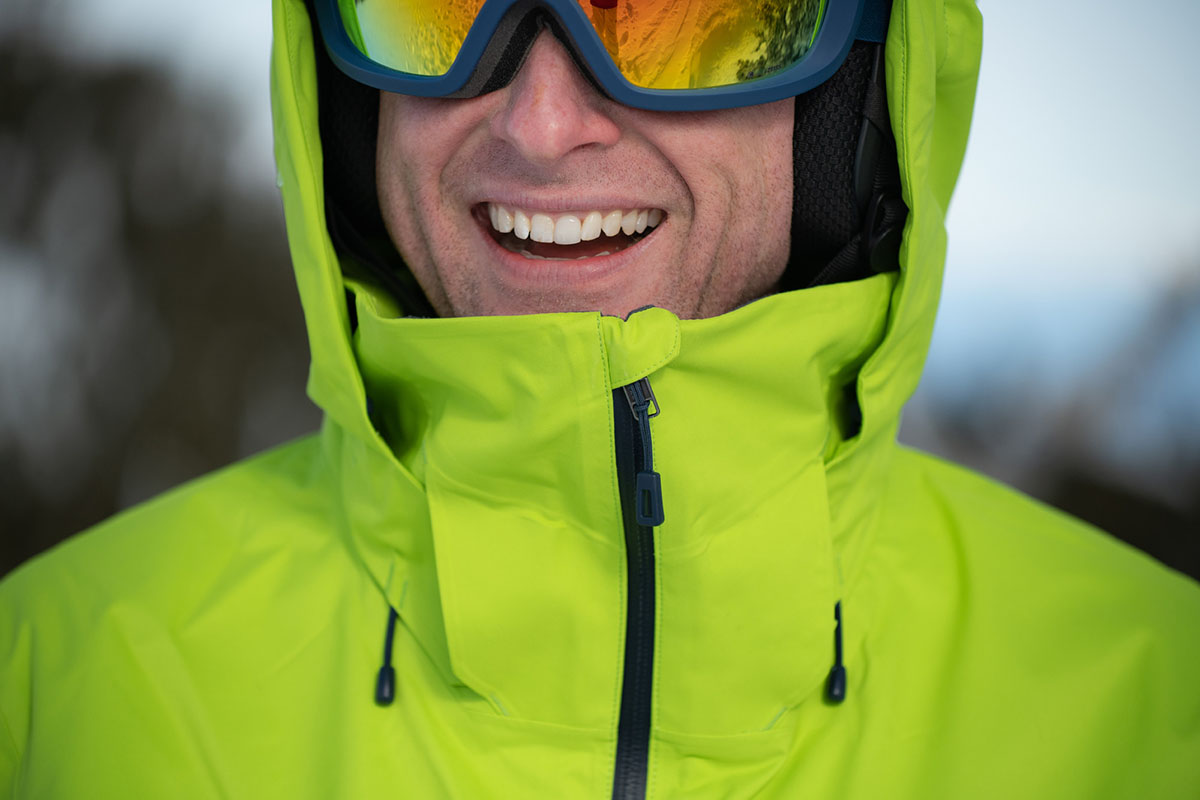
| Jacket | Price | Best For | Insulation | Waterproof | Weight |
|---|---|---|---|---|---|
| Patagonia 3-in-1 Snowshot | $399 | Resort | 60g Thermogreen | 2L H2No | 2 lb. 15.1 oz. |
| TNF ThermoBall Eco Triclimate | $349 | Resort | 80g PrimaLoft Silver | 2L DryVent | 2 lb. 13.9 oz. |
| Columbia Wild Card Interchange | $320 | Resort | 650-fill down | Polyester | Unavail. |
| Helly Hansen Alpha 3.0 | $450 | Resort | 80g PrimaLoft Black | 2L Helly Tech | 2 lb. 3 oz. |
| Patagonia Insulated Snowshot | $329 | Resort | 80 & 40g Thermogreen | 2L H2No | 2 lb. 0.5 oz. |
The Patagonia Snowshot ski jacket offers 3-in-1 versatility in a protective and durable design. That said, there are a number of other integrated options on the market that we think outperform the Patagonia. For example, The North Face’s ThermoBall Eco Snow Triclimate is the Snowshot’s primary competitor with a similar 3-in-1 design and overall construction. In parsing out the differences, the ThermoBall has a higher-quality interior liner that uses TNF’s proprietary ThermoBall insulation, has a more functional powder skirt, weighs slightly less at 2 pounds 13.9 ounces, and saves you $50 at $349. To be sure, the ThermoBall still comes with compromises—including sacrifices in comfort and freedom of movement—and isn’t a true performance piece, but we think it’s the superior 3-in-1 option.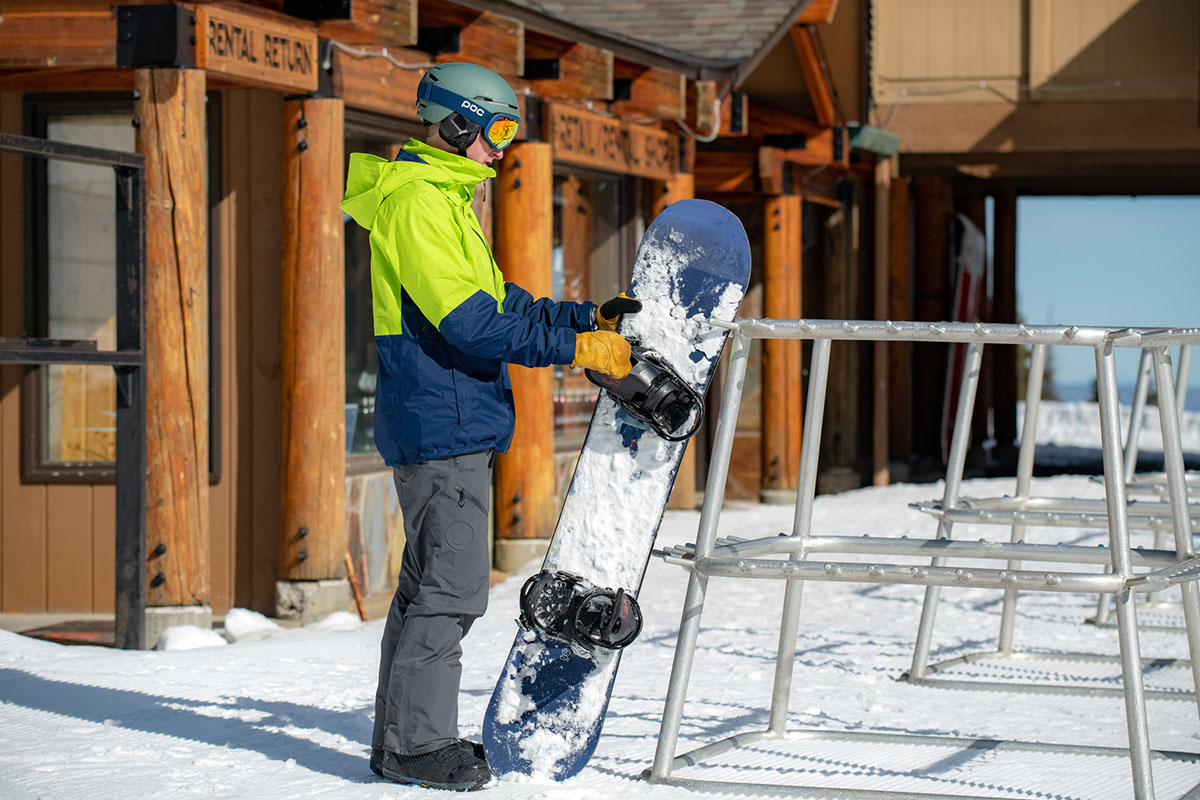
Another 3-in-1 model to consider is Columbia’s Wild Card Interchange. Rather than synthetic insulation, the Wild Card uses down fill (in this case, 650-fill), which is warmer for the weight but will wet out and grow soggy quickly in sustained moisture (a major benefit of synthetic like the Patagonia’s Thermogreen is that it still insulates when wet). Columbia products in general also have cheaper build quality, but the Wild Card does cost around $80 less at $320. In the end, if you’re alright with the inherent risks of a down midlayer, the Wild Card is the superior 3-in-1 design and a better value.
Moving outside of 3-in-1 jackets, our current favorite insulated resort design is the Helly Hansen Alpha 3.0. The most noteworthy feature on the Helly Hansen is its stretchy and comfortable fit, which is a great match for active inbounds use. Unlike the Snowshot, we also found the Alpha to have an incredibly functional and well-executed feature set, including ample storage, an adjustable and protective hood, and even a dedicated insulated pocket for stowing a phone (we struggled to find usable space for our phone with the Snowshot). The Alpha is pricier at $450 and lacks the versatility of forgoing the midlayer or wearing it around town separately, but we think the boost in performance is worth these tradeoffs for dedicated resort-goers.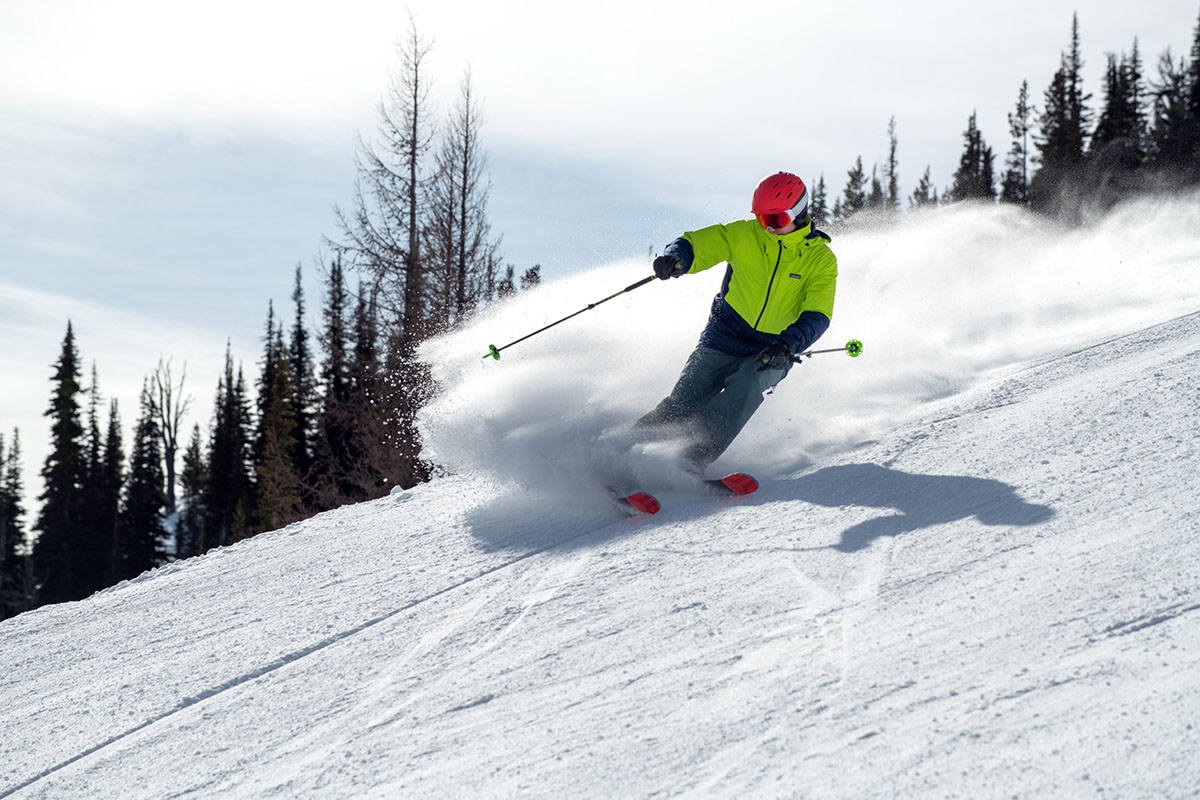
A final competitor to consider is the standard insulated version of the Snowshot. As we mentioned above, we found that model outperformed the 3-in-1 almost across the board: it gets the clear edge in comfort with a smooth and supple lining, has more functional features including five easily accessible pockets, and costs less at $329. The 3-in-1 is warmer and technically a better value with the separate insulated jacket, but the drop in performance is noticeable. In our opinion, the Insulated Snowshot is the better buy, and especially if you already have a midlayer to pair underneath when the mercury drops.
If you’re thinking about buying gear that we’ve reviewed on Switchback Travel, you can help support us in the process. Just click on any of the seller links above, and if you make a purchase, we receive a small percentage of the transaction. The cost of the product is the same to you but this helps us continue to test and write about outdoor gear. Thanks and we appreciate your support!
Depending on the seller, most products ship free in the United States on orders of $50 or more. International shipping availability and rates vary by seller. The pricing information on this page is updated hourly but we are not responsible for inaccuracies.